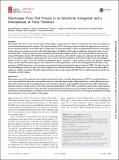Files in this item
Bluetongue virus NS4 protein is an interferon antagonist and a determinant of virus virulence
Item metadata
| dc.contributor.author | Ratinier, Maxime | |
| dc.contributor.author | Shaw, Andrew E. | |
| dc.contributor.author | Barry, Gerald | |
| dc.contributor.author | Gu, Quan | |
| dc.contributor.author | Di Gialleonardo, Luigina | |
| dc.contributor.author | Janowicz, Anna | |
| dc.contributor.author | Varela, Mariana | |
| dc.contributor.author | Randall, Richard E. | |
| dc.contributor.author | Caporale, Marco | |
| dc.contributor.author | Palmarini, Massimo | |
| dc.date.accessioned | 2016-06-20T11:30:15Z | |
| dc.date.available | 2016-06-20T11:30:15Z | |
| dc.date.issued | 2016-06-01 | |
| dc.identifier | 243532807 | |
| dc.identifier | 7de035ba-f2a4-492e-8849-6e28d15bfdee | |
| dc.identifier | 84971422010 | |
| dc.identifier | 000376160200019 | |
| dc.identifier.citation | Ratinier , M , Shaw , A E , Barry , G , Gu , Q , Di Gialleonardo , L , Janowicz , A , Varela , M , Randall , R E , Caporale , M & Palmarini , M 2016 , ' Bluetongue virus NS4 protein is an interferon antagonist and a determinant of virus virulence ' , Journal of Virology , vol. 90 , no. 11 , pp. 5427-5439 . https://doi.org/10.1128/JVI.00422-16 | en |
| dc.identifier.issn | 0022-538X | |
| dc.identifier.other | RIS: urn:9C669EE2BF0DEA91F50EB236FFBBAE0C | |
| dc.identifier.other | ORCID: /0000-0002-9304-6678/work/60427001 | |
| dc.identifier.uri | https://hdl.handle.net/10023/9018 | |
| dc.description | This work, including the efforts of Massimo Palmarini, was funded by Wellcome Trust. | en |
| dc.description.abstract | Bluetongue virus (BTV) is the causative agent of bluetongue, a major infectious disease of ruminants with serious consequences to both animal health and the economy. The clinical outcome of BTV infection is highly variable and dependent on a variety of factors related to both the virus and the host. In this study, we show that the BTV nonstructural protein NS4 favors viral replication in sheep, the animal species most affected by bluetongue. In addition, NS4 confers a replication advantage on the virus in interferon (IFN)-competent primary sheep endothelial cells and immortalized cell lines. We determined that in cells infected with an NS4 deletion mutant (BTV8ΔNS4), there is increased synthesis of type I IFN compared to cells infected with wild-type BTV-8. In addition, using RNA sequencing (RNA-seq), we show that NS4 modulates the host IFN response and downregulates mRNA levels of type I IFN and interferon-stimulated genes. Moreover, using reporter assays and protein synthesis assays, we show that NS4 downregulates the activities of a variety of promoters, such as the cytomegalovirus immediate-early promoter, the IFN-β promoter, and a promoter containing interferon-stimulated response elements (ISRE). We also show that the NS4 inhibitory activity on gene expression is related to its nucleolar localization. Furthermore, NS4 does not affect mRNA splicing or cellular translation. The data obtained in this study strongly suggest that BTV NS4 is an IFN antagonist and a key determinant of viral virulence. IMPORTANCE. Bluetongue is one of the main infectious diseases of ruminants and is caused by bluetongue virus (BTV), an arthropod-borne virus transmitted from infected to susceptible animals by Culicoides biting midges. Bluetongue has a variable clinical outcome that can be related to both virus and host factors. It is therefore critical to understand the interplay between BTV and the host immune responses. In this study, we show that a nonstructural protein of BTV (NS4) is critical to counteract the innate immune response of the host. Infection of cells with a BTV mutant lacking NS4 results in increased synthesis of IFN-β and upregulation of interferon-stimulated genes. In addition, we show that NS4 is a virulence factor for BTV by favoring viral replication in sheep, the animal species most susceptible to bluetongue. | |
| dc.format.extent | 13 | |
| dc.format.extent | 4173998 | |
| dc.language.iso | eng | |
| dc.relation.ispartof | Journal of Virology | en |
| dc.subject | QH301 Biology | en |
| dc.subject | QR355 Virology | en |
| dc.subject | SDG 3 - Good Health and Well-being | en |
| dc.subject.lcc | QH301 | en |
| dc.subject.lcc | QR355 | en |
| dc.title | Bluetongue virus NS4 protein is an interferon antagonist and a determinant of virus virulence | en |
| dc.type | Journal article | en |
| dc.contributor.institution | University of St Andrews. School of Biology | en |
| dc.contributor.institution | University of St Andrews. Biomedical Sciences Research Complex | en |
| dc.identifier.doi | 10.1128/JVI.00422-16 | |
| dc.description.status | Peer reviewed | en |
This item appears in the following Collection(s)
Items in the St Andrews Research Repository are protected by copyright, with all rights reserved, unless otherwise indicated.

